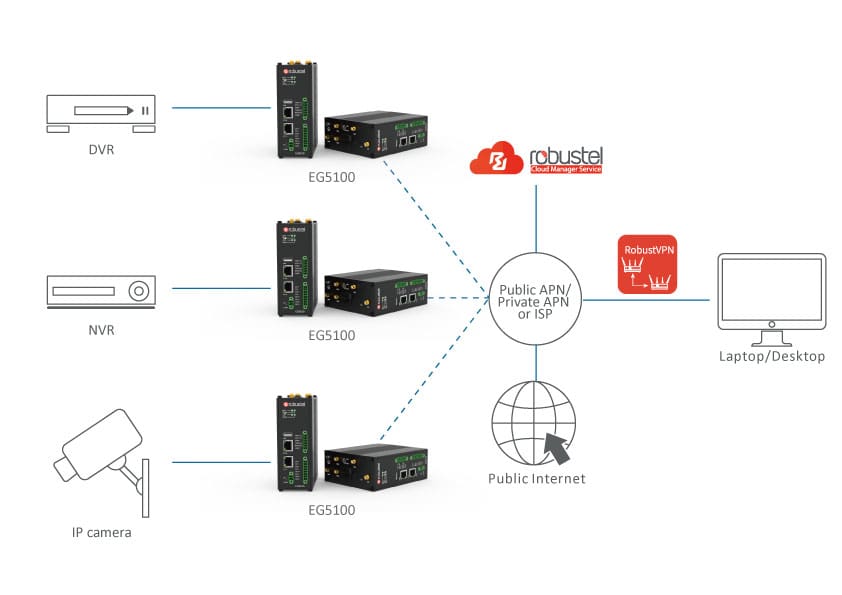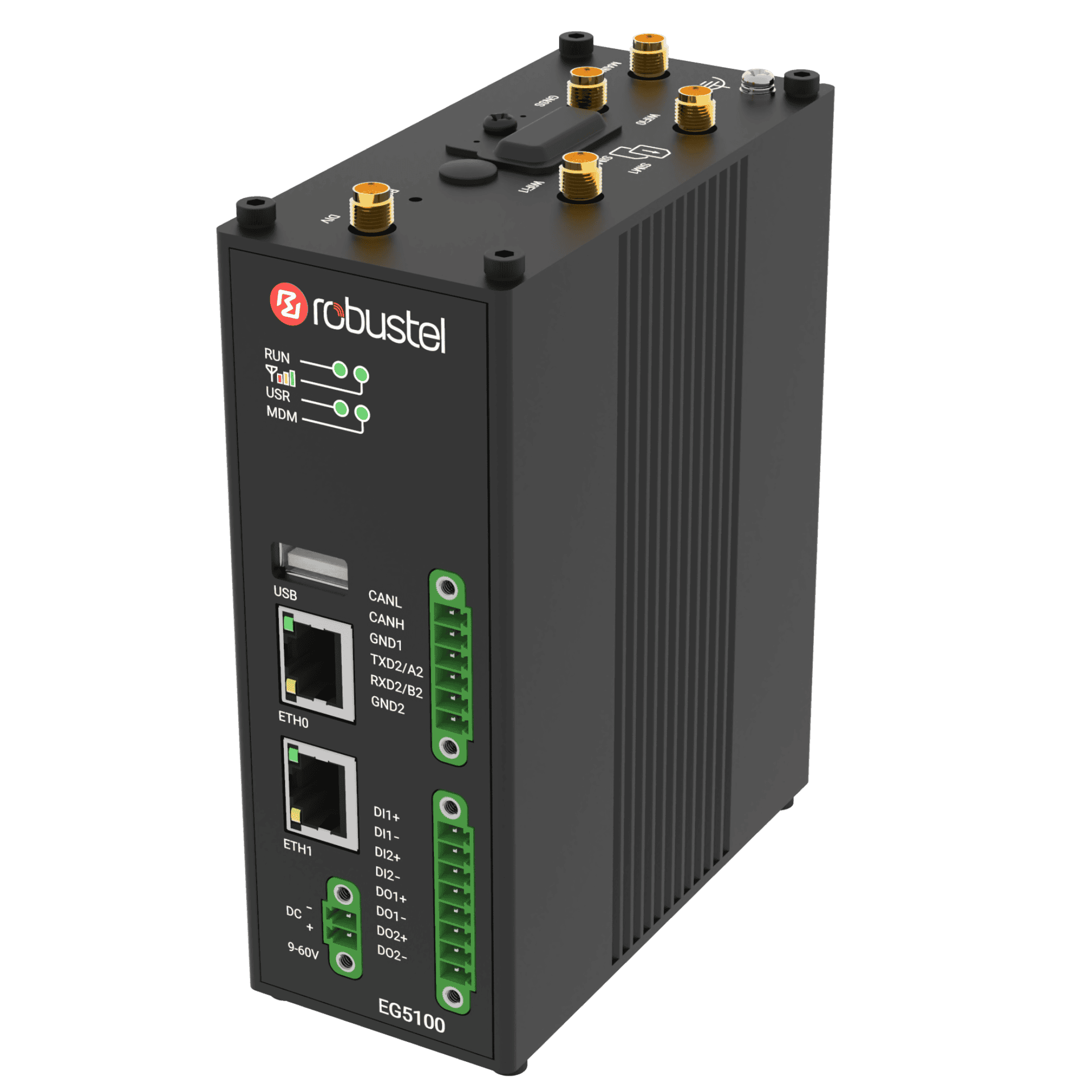Public Safety CCTV Camera Connectivity and Remote Access Using the EG5100
A Robustel Application Example
Application Example – Fast Facts
Industry
Smart Cities and Municipal Infrastructure (public safety cameras, transport hubs, depots, critical sites)
Product(s)
Robustel EG5100 Edge Computing Gateway; RCMS (RobustLink, RobustVPN)
Challenges
Cities and operators need reliable access to remote cameras for incident review, security, vandalism claims and public safety reporting. Many cameras sit on poles, in shelters, or at temporary sites with no fibre and no practical way to get IT staff on location when there’s a fault.
Expected Outcomes
Use the EG5100 as the local gateway at each camera site or cluster. Backhaul video streams and status over LTE. Give authorised teams secure remote access for diagnostics, footage retrieval and maintenance without sending a technician to the pole every time something looks offline.
Remote Monitoring and Control for Water Networks and Treatment Assets
Modern public safety camera networks are not just a few feeds in a control room. They are spread across intersections, transport hubs, parks, service yards, temporary works zones and council facilities. They are expected to deliver usable footage when something happens, and they are expected to be working when someone asks, “Do you have coverage there?”
The difficulty is not the camera itself. The difficulty is keeping that camera reachable.
Many of these camera locations have no fibre, no spare LAN port, and no safe place for a full-size NVR. Some are powered from lighting poles. Some are solar. Some are in areas that are hard to access or that require two-person safety procedures just to open the cabinet. When a feed drops, there is immediate pressure from operations, policing partners, insurers or local government. Getting a person out there with a laptop for a basic reset is slow and costly.
The EG5100 solves the reachability problem. It sits on site beside the camera or small camera cluster, provides secure 4G/LTE connectivity, and exposes controlled remote access so support teams can check link health, assess bandwidth, pull footage or reboot equipment without physically visiting the pole. This keeps public safety camera infrastructure serviceable at city scale, instead of location by location.
Business Challenges
Before we describe the deployment model, it’s important to acknowledge what actually causes pain for councils, transport authorities and security contractors.
- If a camera is “there but dark,” accountability questions start immediately: After an incident, people expect proof. If the feed was down, the city has to explain why. That can become a legal, insurance or reputational issue. You cannot wait two days for someone to visit the mast and tell you it was just a hung connection.
- Most camera locations are not network-friendly sites: A lot of public cameras sit on street furniture, transit shelters, construction perimeters or depots. There is no structured network drop. There is often no building IT team to lean on. You might have power, but you do not have a clean, managed data path.
- Rolling a van to every alert burns budget fast: Sending field techs to check cameras one by one is expensive. Some sites need traffic management or access permits. Others need two-person attendance for safety. Doing that just to reboot a small device is wasteful, but without remote access you have no alternative.
- Bandwidth and latency vary by location: Not every site can push full-resolution video 24/7. You may have to choose which streams are live and which are buffered and uploaded. You also need enough link quality to retrieve stored footage remotely without corrupting evidence.
- Security and auditability matter: Access to these cameras is often shared between different parties: city operations teams, outsourced maintenance, contracted security providers, sometimes law enforcement. That means you need a way to grant access without handing out broad, persistent credentials.
Solution Overview

Each camera site (or small group of cameras) was equipped with an EG5100. The EG5100 provides cellular backhaul, local processing, and controlled remote access. All gateways are then managed centrally.
- Local gateway and backhaul at the pole or enclosure: The EG5100 sits in the same housing as the CCTV camera or in a nearby cabinet. It connects to the camera via Ethernet. It then uses LTE to send video streams or snapshots upstream, or to make that camera reachable on demand.
- Resilient connectivity for standalone and temporary sites: Because the EG5100 supports cellular backhaul, you can deploy cameras in locations that have no wired network and may never get one: temporary public works, events, pop-up safety zones, depots on leased land, remote parking or laydown areas. The link belongs to you, not the landlord.
- Remote diagnostics and controlled access: Support teams can reach the site through the EG5100 to check if the camera is powered, if the network link is up, if the bitrate is throttling or if storage is full. They can perform basic recovery steps without leaving the control centre. Access can be time limited and scoped to a specific device or site.
- Edge capability for smarter use of bandwidth: The EG5100 is more than a modem. As an edge computing gateway running RobustOS Pro (a Debian-based environment), it can host lightweight applications at the pole. That can include buffering footage for later retrieval, generating still images for periodic compliance checks, or pre-filtering what gets sent upstream so you’re not paying to move everything live.
- Portfolio visibility in RCMS: All deployed EG5100 units check in to RCMS. Operations can see which camera sites are online, which ones are struggling for signal, and which ones have recently changed configuration. This gives you an organised view of a whole estate rather than a list of addresses and post-it notes.
Expected Customer Outcomes
What success looks like for the Operator and the Integrator/Installer
For the operator:
- Live visibility of each camera location — including remote poles, temporary works zones, and problem hotspots — without sending a crew to confirm “is it up?”
- Faster response when something matters. You can check link health, signal quality, and power state from the control room and take action before you lose footage.
- Clear evidence for incident review. When police, insurers, or legal teams ask “was that camera working at this time?”, you can answer with logs instead of guesswork.
- Coverage in places that were previously impractical (no fibre, no building LAN). That means fewer dark spots in public areas.
- A defensible record of connectivity, uptime, and access — useful when there is public scrutiny around safety, privacy, or data handling.
For the integration / installation partner:
- A repeatable deployment pattern: one EG5100 per pole or enclosure, pre-configured, remotely supportable. Less time on lifts and less out-of-hours callout.
- The ability to troubleshoot without rolling a truck. You can check throughput, run basic diagnostics, and plan remedial work with facts instead of trial-and-error.
- Ongoing service value, not just a one-time install. Because the operator now depends on the link for both live monitoring and proof of service, support becomes part of the contract, not an afterthought.
Featured Products
Robustel EG5100 Edge Computing Gateway

RCMS Cloud Device Management

Talk to an Expert
If you are responsible for public safety cameras, transport hubs or remote depot security, you know the expectation: “Show me what happened, right now.”
Let’s talk about giving every key camera location a reliable connection and controlled remote access, without having to build fixed network infrastructure at every pole.
